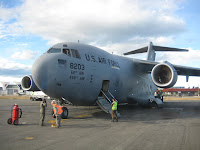1. Where do you go to the bathroom?
This depends on where I am in Antarctica. Right now I am at McMurdo, which is a small town in Antarctica. Right now there are about 1200 people here, but nobody lives here permanently and most people leave before winter (remember winter here is during the summer months in Michigan). Here we have running water and plumbing and bathrooms like you have at home or at school in Michigan.
This depends on where I am in Antarctica. Right now I am at McMurdo, which is a small town in Antarctica. Right now there are about 1200 people here, but nobody lives here permanently and most people leave before winter (remember winter here is during the summer months in Michigan). Here we have running water and plumbing and bathrooms like you have at home or at school in Michigan.
The last couple of weeks, however, I was living out at a field camp near where we were collecting samples. At the field camp we had to use an outhouse (below)
The tough part is human waste has to be separated into liquids and solids, so we can only do one thing or the other. Not both at the same time. We end up sealing solid waste in "Poo Buckets" and liquid waste in "Pee Barrels" and these are transported out of the Dry Valleys by helicopter. The Pee Barrel is that orange barrel next to the outhouse in the second picture. The poo bucket is in that wood box with a toilet seat on top of it.
I'll talk more about the difference between life at McMurdo and life at field camps later.
2. What do you do if you run out of food?
We check in daily with the people at McMurdo who manage all of the science field groups in the area. When we are low on food we call in a request with the folks at McMurdo and the send the food out on a helicopter. When we go on day trips or anywhere far from a base camp we take an emergency kit with us that has dehydrated food in it. If we run our of food we just need to add boiling water to these dehydrated food packets and we have a meal that will keep us going. They pack enough food, a stove, and fuel in the emrgency kits to keep two people a live for 3 days. I haven't had to eat this food yet (except in my training when I fist got here). Hopefully I won't need to use the emergency kits while I'm here. This dehydrated food is similar to the type of food you can buy at outdoors stores for backpack camping. I have had it quite a few times backpacking in the U.S.
We check in daily with the people at McMurdo who manage all of the science field groups in the area. When we are low on food we call in a request with the folks at McMurdo and the send the food out on a helicopter. When we go on day trips or anywhere far from a base camp we take an emergency kit with us that has dehydrated food in it. If we run our of food we just need to add boiling water to these dehydrated food packets and we have a meal that will keep us going. They pack enough food, a stove, and fuel in the emrgency kits to keep two people a live for 3 days. I haven't had to eat this food yet (except in my training when I fist got here). Hopefully I won't need to use the emergency kits while I'm here. This dehydrated food is similar to the type of food you can buy at outdoors stores for backpack camping. I have had it quite a few times backpacking in the U.S.
3. What happens if you get sick? Do you have medicine with you?
I had to undergo an extensive check up and I had to get lots of shots before I came here. There are some medical resources here. We have first aid kit in the field and there is a medical doctor and a clinic at McMurdo, but we have to get airlifted back to New Zealand if anything serious happens. There are lots of people who are well trained in first aid to care for people who get hurt, but it's a long way back to a country with a real hospital.
4. Do you get to change clothes?
I get to change clothes a lot more when I'm in McMurdo. While I was at the field camp I only had 5 pairs of socks and three sets of long underwear for nearly three weeks. I was pretty smelly when I got back to McMurdo. I immediately changed into my regular clothes when I made back, and put my stinky field clothes in the wash. The dorms at McMurdo have laundry machines.
5. Is is negative degrees there?
The temperatures can be negative even during the summer. Right now it is -9.5 degrees Celsius, which is 15 degrees Fahrenheit . It has been below zero Fahrenheit a few days while I have been here, but it hasn't been too cold recently. I have been told that it will be much colder at a field camp I am going to at the end of this week at Beardmore Glacier. McMurdo is at sea level, but the camp at Beardmore Glacier is at a much higher elevation (I think 6000 ft), is much farther south, and is on a glacier, so I think those three factors will combine to make it pretty cold.















